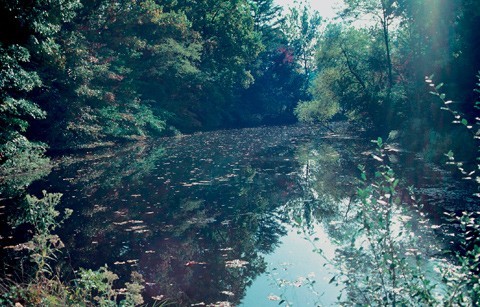
Today Swan Cove is a small, abayed pond. Three hundred and fifty years ago it was probably navigable for small boats—the main form of transportation for the Puritan settlement of Providence. (Photo, Al Luckenbach.)
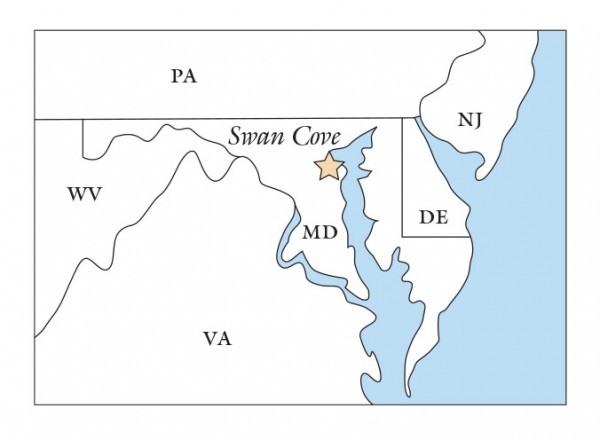
The Swan Cove kiln site was discovered in Anne Arundel County, Maryland, on the western shore of the Chesapeake Bay.
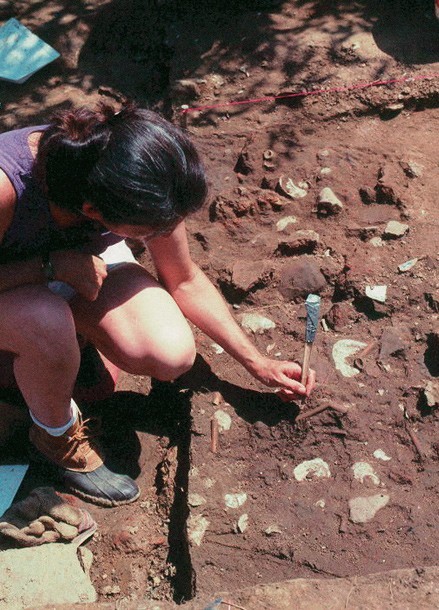
Anne Arundel County’s Historic Sites Planner, Donna Ware, excavates Feature 19 at Swan Cove. This feature was one of several undisturbed trash pits filled with pipe kiln debris and wasters. (Photo, Al Luckenbach.)

Emanuel Drue’s 1669 estate inventory listing. (Courtesy, Maryland State Archives.)

A detail from Feature 7 at Swan Cove shows muZe fragments, loaves, a prop, glazed cobbles, and pipe wasters, along with domestic debris such as oysters and delftware sherds. Feature 7 contained over 160 pounds of kiln debris along with nearly 1,200 pipe fragments. (Photo, Al Luckenbach.)
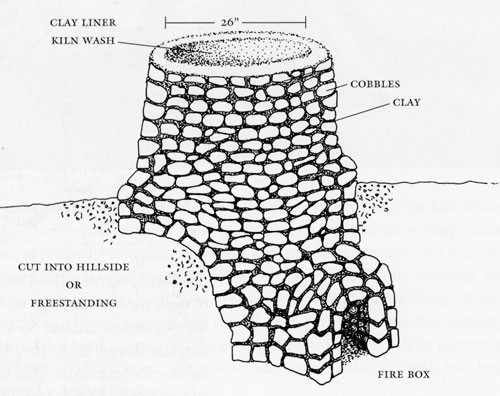
Conjectural drawing of the Emanuel Drue pipe kiln. (Drawing, Lost Towns Project, Anne Arundel County, Maryland.)
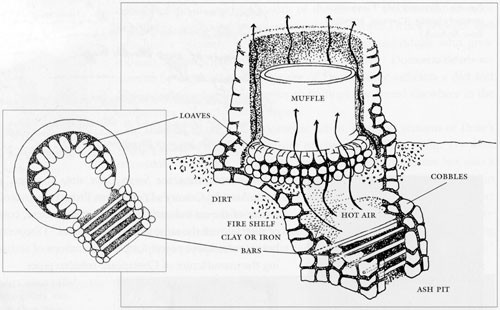
Conjectural drawing of the Emanuel Drue pipe kiln. (Drawing, Lost Towns Project, Anne Arundel County, Maryland.)
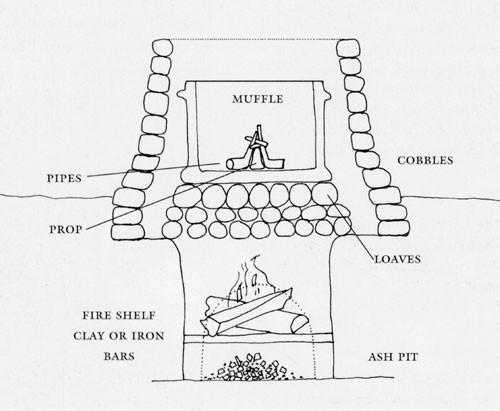
Conjectural drawing of the Emanuel Drue pipe kiln showing the placement of the muffle and the interior arrangement of the pipes and props. (Drawing, Lost Towns Project, Anne Arundel County, Maryland.)

Crude, handmade, redware objects roughly the size and shape of bread were given the term loaves. These apparently took the place of more traditional bricks in the kiln’s flooring and perhaps its sides. (Photo, Gavin Ashworth.)

Numerous non-native quartzite cobbles, many of which display heat alterations, litter the Swan Cove site. The vitrified surface of this extreme example clearly indicates their use as part of the kiln’s construction. (Photo, Gavin Ashworth.)
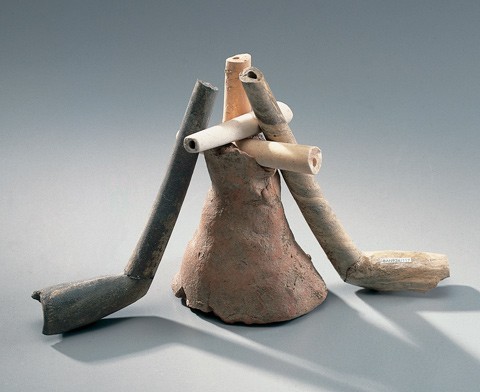
A redware cross-pipe prop was built incorporating broken pipe stem fragments and used to brace tobacco pipes during the firing of Emanuel Drue’s kiln. Two examples were recovered. (Photo, Gavin Ashworth.)
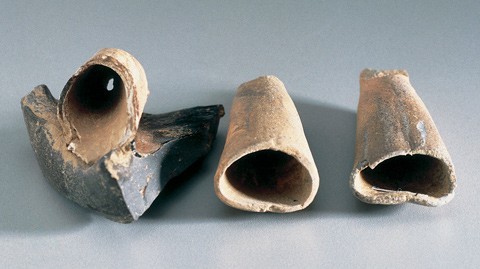
Pipe bowl wasters demonstrating distortion caused during firing while leaning against cross-pipe props. (Photo, Gavin Ashworth.)
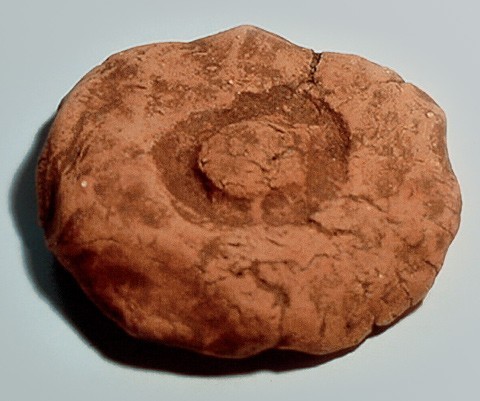
A redware object called a “bun,” which may have been used to stack props. (Photo, Al Luckenbach.)
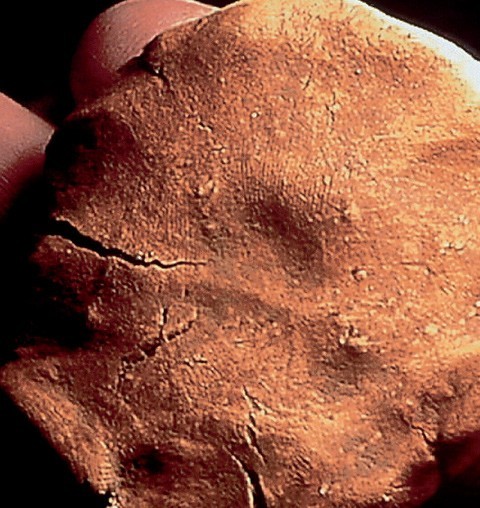
The reverse side of the bun bears the clear impressions of finger and palm prints. Presumably these belong to Emanuel Drue, imprinted over 350 years ago. (Photo, Al Luckenbach.)
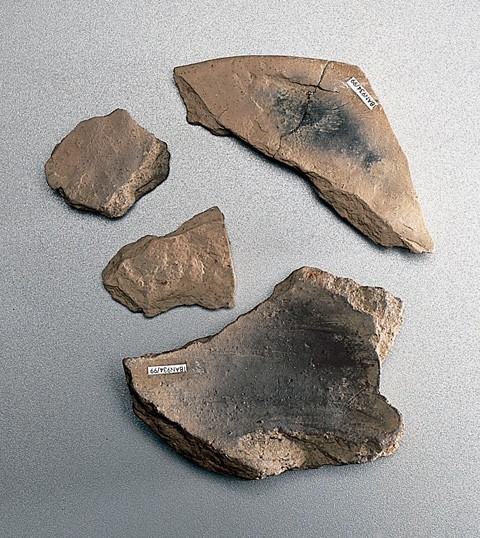
A crude, highly fired redware dish, which Emanuel Drue presumably made for some expedient purpose involving pipe making. (Photo, Gavin Ashworth.)
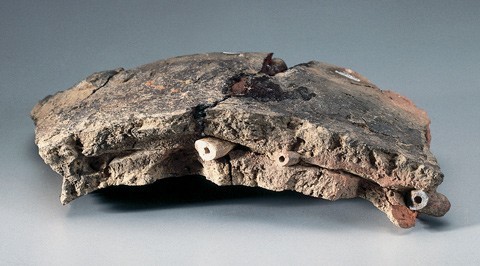
A fragment of the muffle showing the utilization of broken pipe stems as a bond between coils during construction. (Photo, Gavin Ashworth.)

Muffle sherd from the side showing herringbone pattern produced with pipe stems on alternating coils. (Photo, Gavin Ashworth.)
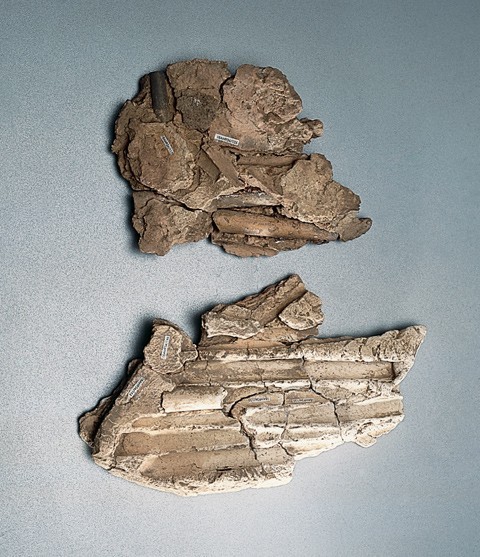
The interior base of each muffle contained layers of broken pipe stems. (Photo, Gavin Ashworth.)
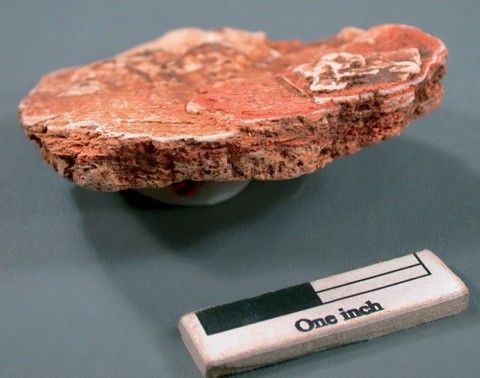
Repeated application of a clay wash on the muffle interior produced a laminar structure called “lute.” (Photo, David Gadsby.)

The Drue tobacco pipe Type A is a typical Chesapeake-style angular-elbow pipe. (Photo, Gavin Ashworth.)
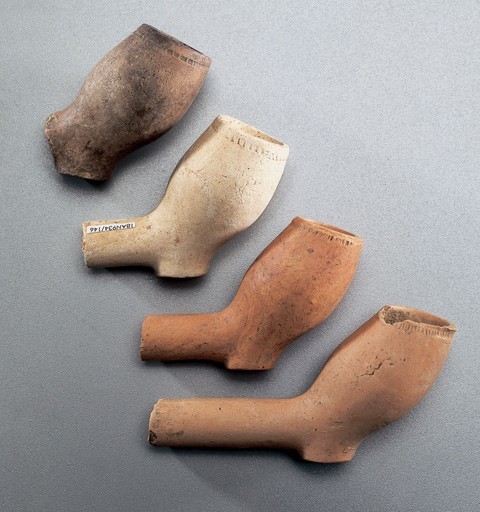
Drue’s Type B tobacco pipe is in the form of a classic English “belly bowl,” typical of the mid-seventeenth century. (Photo, Gavin Ashworth.)

Variations of Chesapeake-style decoration appearing on Drue Type A pipe examples. (Photo, Gavin Ashworth.)
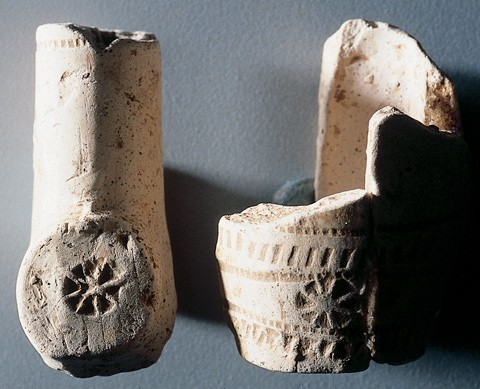
Unique examples of exuberant Chesapeake-style decoration on Drue Type B, perhaps representing a single specimen. (Photo, Gavin Ashworth.)

Three different stamps were utilized by Emanuel Drue in the production and decoration of his pipes. These have been termed Stamp Types 1, 2, and 3. (Photo, Gavin Ashworth.)

Three different stamps were utilized by Emanuel Drue in the production and decoration of his pipes. These have been termed Stamp Types 1, 2, and 3. (Photo, Gavin Ashworth.)

Three different stamps were utilized by Emanuel Drue in the production and decoration of his pipes. These have been termed Stamp Types 1, 2, and 3. (Photo, Gavin Ashworth.)
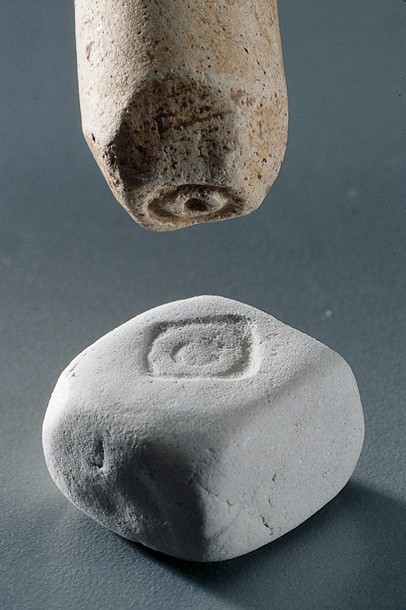
Stamp tool found at Swan Cove that was used to produce Type 1. This frequently utilized tool was found broken in half and appears to be constructed from an unbored pipe stem. (Photo, Gavin Ashworth.
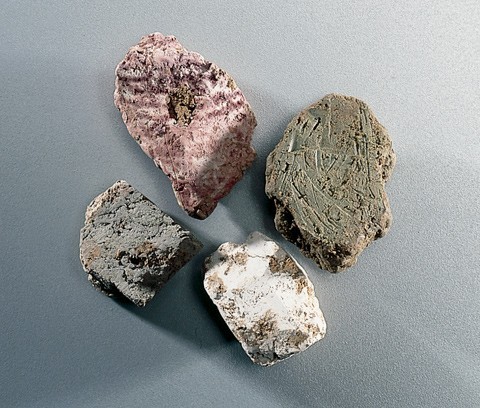
Raw, unfired clay from intact feature deposits at Swan Cove. These “gourmet clays” were utilized by Drue to produce products that were amazingly variable in color. (Photo, Gavin Ashworth.)
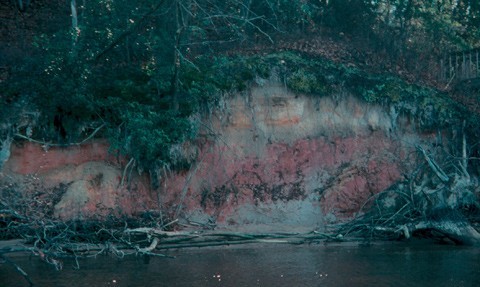
Source of white, pink, and green clays exposed on the banks of the Severn River that were exploited by Drue. This bank is located over thirteen miles away from Swan Cove. (Photo, C. Jane Cox.)
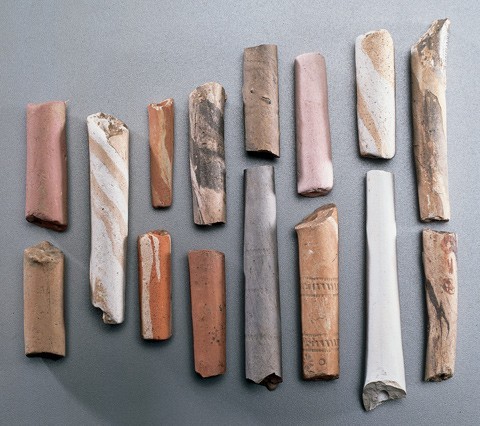
Tobacco pipe stems, Emanuel Drue, Maryland. Examples of the myriad color variations achieved by Drue through the mixing of diVerent color clays as well as slipping their exteriors. (Photo, Gavin Ashworth.)
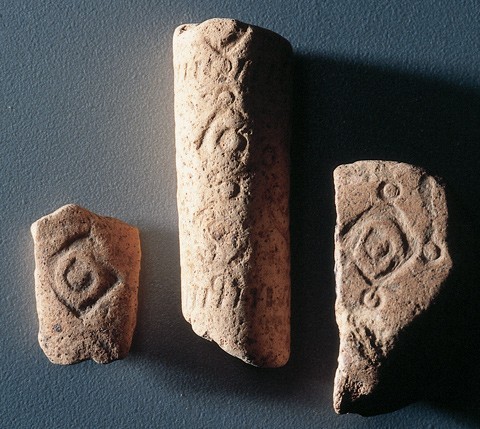
Three pieces of a pipe with a distinctive, very large heel termed Drue Type C. These sherds were excavated at the Burle Site at Providence nearly a decade before the stamp itself was recovered at Swan Cove. (Photo, Gavin Ashworth.)
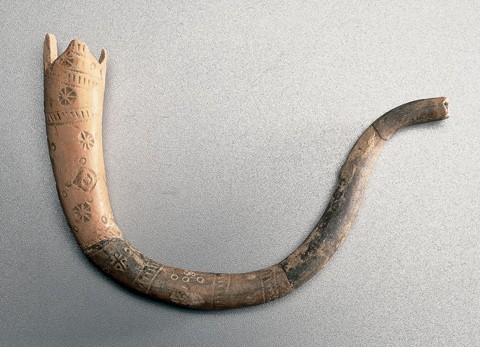
Drue Type D. (Photo, Gavin Ashworth.) Called a “crumm horn” (or crooked horn) pipe in Holland, this example is assumed to be one of Drue’s presentation pieces. It is a unique form, with ninety-four separate decorative elements.
Chesapeake pipes are notable because they are craft items, meticulously made, and beautifully decorated. They are the most intriguing surviving examples of folk art of the early Chesapeake. The care and effort which attended the creation of these artifacts attest to their symbolic importance for those who used them. The designs on these pipes have things to tell us about life in a distant past. If we can "read" these pipes, perhaps we can hope to fathom something of the essence of American culture as it was created from the interactions of diverse people on the early Chesapeake frontier.[1]
The Swan Cove Site
Between the protective arms of Greenbury and Hackett's Points, Whitehall Bay opens out on the broader Chesapeake Bay near the mouth of the Severn River. In the mid-seventeenth century, off a tributary called Ferry Creek (or Mill Creek as it is known today), a small but navigable cove was named for its current inhabitants, native swans (fig. 1).
Englishman Emanuel Drue lived out his life on Swan Cove in the 1650s and 1660s, when the region was on the frontier of European settlement. Only a decade or so earlier, however, what is now Anne Arundel County, Maryland, had been the sole domain of the Susquehannoch Indians (fig. 2), who harvested the region's natural resources — oysters, fish, terrapin, migratory fowl — flourishing in almost unimaginable abundance.
Drue apparently pursued a lifestyle like those of his neighbors. He lived in a scattered, hamlet-style settlement called Providence, a Puritan town established in 1649 at the mouth of the Severn.[2] Documentation from Providence, the county's earliest settlement, records Drue's presence and calls him a "planter," a term applied to landed individuals who grew tobacco, the principal crop of the Chesapeake Bay.[3] Domestic debris recovered by archaeologists at the site of Drue's home indicates a diet and material standard of living similar to findings discovered elsewhere in the community and surrounding region.
In addition to the mix of domestic debris, extensive remains of Drue's cottage industry — the manufacture of clay tobacco pipes (fig. 3) — were recovered. Apparently, Emanuel Drue was not only a planter but also a potter, a scientist, and, as archaeologist Dan Mouer suggests, an artist in clay. The surviving historical record contains scarcely any clues to support these extraordinary facts. Indeed, only a single line in the two-page probate inventory taken at Drue's death in 1669 hints at his diversity, listing "One payre of pype Moulds brass and materials belong to them" (fig. 4).[4]
While excavating the Swan Cove site, however, archaeologists from Anne Arundel County's Lost Towns Project discovered clear evidence that a state-of-the-art industrial kiln once existed there, constructed in the style of pipe kilns of the same period in England.[5] Discovery of the kiln site has been a remarkable payoff for two generations of archaeologists investigating the manufacture of Chesapeake tobacco pipes.
Emanuel Drue's Pipe Kiln
Although the search continues, the centuries-old foundation of the kiln remains elusive. It is possible that it did not survive the ravages of time, as plowing, erosion, grading, and ditch digging have all occurred on the site. Nonetheless, the vast quantity of kiln debris found inside several intact trash features appears to represent periodic rebuilding of the structure and contains invaluable clues to the nature of its construction (figs. 5-8).
Handmade clay objects called loaves, shaped vaguely like fresh-baked bread, represent part of the kiln's interior structure. Loaves exhibit clear evidence of high firing on one face (top or side) and a soft, "salmon brick" consistency on the other. Drue's fingerprints confirm the handmade nature of these ovoid shapes (fig. 9), which were either an integral part of the kiln floor or objects that had been set in place. Interestingly, no traditional, rectangular-shaped bricks have been found, although they would have been easy for Drue to make. Even the imported, yellow Dutch bricks commonly encountered on other Providence sites are not in evidence at Swan Cove. Numerous river cobbles have been recovered, however, that appear to have been used in the kiln construction, as some recovered examples display one surface with a vitrified glaze resulting from exposure to extremely high temperatures (fig. 10).
Fragments of Dutch roof pantiles were also found with the kiln debris. At other Providence sites these reddish tiles were used for roofing material, as originally intended. At Swan Cove, their dark burned color indicates they had been subjected to the kiln's high temperatures after breaking, and must have served in some fashion as spacers or props during firings. British archaeologist and tobacco kiln expert Allan Peacey submits they may also have been used to seal the tops of the kiln muffles (receptacles protecting the pipes) before firing.[6] Recovered heat-altered redware sherds may have served a similar function.[7]
Other, more traditional kiln furniture has survived, including the unique form of a "cross-pipe" prop (fig. 11) that heretofore has been known only from an example found in Chelmsford, England.[8] Flattened pipe bowl wasters (fig. 12) further attest to the use of such props.
Another, fairly enigmatic find is, perhaps, a "bun" (fig. 13), at least based on the definitions contained in a study of English kilns by Allan Peacey.[9] The bun's reverse side is notable for having captured what is presumably Drue's palm print (fig. 14). Fragments of a possible kiln "dish" were also found (fig. 15), and its crude, handmade form argues strongly for a limited or specific use.
By far the most numerous kiln-related artifacts are fragments of muffles or saggers — large, rough, ceramic vessels that held the pipes during firing. Whether they are actually muffles or saggers is an interesting definitional dilemma. Functionally, if they can be moved in and out of the kiln, they should be termed saggers, and those from Swan Cove show no clear evidence of having been permanently fixed. On the other hand, they fit the definition of muffles compositionally, since they are vessels tempered with pipe fragments, a trait unknown in saggers.[10]
The muffle's intriguing physical attributes reveal important clues to Drue's manufacturing activities (figs. 16-18). Essentially, muffles are large clay vats with buttresses that separate them in the kiln. Their clay is tempered by the unusual addition of similarly sized pipe-stem wasters. Arranged in alternating, angled rows, the pipe fragments form a herringbone pattern, a style that Peacey attributes to the general London area, the possible origin of Drue's training.[11]
To keep the muffle's interior smooth, an interior wash or slip of fine clay, or "lute," was periodically applied, resulting in a laminar or layering effect (fig. 19). Unfortunately the number of layers — up to eight have been noted — does not necessarily indicate an equal number of firings, since the wash was not replaced each time. The interior wash was also one of the first clues indicating Drue's access to a clay that fired to pure white. Other examples of alternating white and terracotta clays have also been observed.
Drue's Tobacco Pipes
The pipes produced by Emanuel Drue would appear overwhelmingly to be products of the two molds mentioned in his 1669 inventory. They include an angular elbow type, a classic "Chesapeake pipe" form, Drue Type A (fig. 20), and a traditional mid-century, English belly-bowl form, Drue Type B (fig. 21). Appearing in approximately equal numbers, the distinction between the two is further reinforced by separate, decorative vocabularies.
Type A bowls seem to follow a decorative grammar derived from the Chesapeake, and not England. They occur in a wide range of colors, including the use of colorfully agatized clays. Besides the application of an exterior slip, they also show a propensity for elaborate decoration (fig. 22).
Drue Type B bowls are decorated in the English style. Although appearing in a wide range of color variations (decidedly not an English characteristic), decoration is limited to simple rouletting around the rim. There are only two exceptions: one — a small fragment of a white belly bowl — appears to have a wheel stamp on its side, and another bears a wheel stamp applied to the base of its heel, much like a traditional English maker's mark (fig. 23). Minimalism and conformity to Old World vocabularies appear to be the predominant decorative traits of Type B.
The imprints of at least eight different pipe-decorating tools have been noted, including three decorative stamps, a smaller circular punch, and four distinct rouletting tools (fig. 24). One of the rarest artifacts recovered from the Swan Cove site is a decorative stamp used by Drue (fig. 25). Even in England, only two have been found during the investigation of over 140 kiln sites; comparable examples from the New World are unknown.[12]
All of Drue's products display an astonishing rainbow of colors. It was first assumed that this variety was indicative of a lack of temperature and oxygen controls in Drue's kiln, since variables of heat can make identical clays fire to different shades and hues. However, as intact trash deposits were excavated and numerous lumps of discarded, unfired clay were recovered, it became apparent that Drue was deliberately experimenting with the production of pipes from different colored clays. Slate gray, green, white, yellow, pink, and variegated pink-white varieties were encountered by excavators. Soon the expression "gourmet clay" was added to the vocabulary (fig. 26). Eventually the clay's sources were located a little more than thirteen miles upstream from the site, on the banks of the Severn River (fig. 27).[13]
Importantly, Drue did more than simply experiment with different color clays; he also mixed them to create agate bodies, created different colored washes, and used clay slips for trailed decoration (fig. 28). His productions reflect both the mind of a scientist and the sensibilities of an artist.
The recovery of two (or three) unique handmade pipes confirms that Drue occasionally felt the need for artistic expression beyond the production of his two standard pipes. This expression is reflected by an example (Drue Type C) recovered from the home of Drue's neighbor, Robert Burle (fig. 29).[14]
Another remarkable pipe, most likely a presentation piece, is Drue's Type D (fig. 30). This extremely unusual pipe seems to have a single parallel — an example recovered in Holland that resides in Don Duco's pipe museum in Amsterdam.[15] The Dutch example is called a "crumm horn pipe" and has been assigned a date of circa 1650.[16]
Until more is learned about Drue's life before he settled in Providence, the hows and whys of his crumm horn pipe could be the source of endless speculation. Most important, perhaps, is the decorative extreme this pipe represents. The Drue crumm horn shows the results of ninety-four individual hand actions involving six different tools — not an economic method for the manufacture of what some perceive to be a fragile and disposable item. This industrious process is particularly noteworthy since the value of labor in the Chesapeake was so high that its expense was considered a driving force in the economy, influencing aspects as diverse as housing construction and the advancement of the slave trade.[17]
Shifting the Paradigm
The terracotta "Chesapeake pipe" and its cultural implications have been a hot topic in seventeenth-century historical archaeology virtually since the inception of the field. From decade to decade, paradigms concerning both the nature of the manufacturing of these pipes and the social implications of their use have changed. For example, the thinking about the pipe's makers has shifted from Native Americans to African Americans to a Creole population that included a European component.[18] Similar theoretical shifts have occurred in perceiving pipe manufacture and use as signs of trade with native populations; as a response to economic vagaries, such as declining tobacco prices; as expressions of African cultural continuity; and as evidence of master-servant relationships.[19] The findings at Swan Cove will further impact these studies — and, thereby, the study of lifeways in seventeenth-century Virginia and Maryland — because convention has been challenged on three theoretical fronts.[20]
The first and most basic shift concerns the archaeologist's ability to accurately identify Chesapeake pipes. The pure white products of Drue's Type B belly-bowl mold defy any previous attribution as Chesapeake pipes. No small matter, in view of the theoretical importance assigned to these artifacts. Archaeologists must now inspect such pipes for evidence of Drue's rouletting tools and hope (probably in vain) that no other manufacturers were making similarly problematic products.
A second shift involves the assumed locus of production. The scraps, trimmings, and "blobs" that have constituted the previous evidence of pipe manufacturing in the Chesapeake appear to have been handmade pipes fired in home fireplaces.[21] The Swan Cove site establishes that Drue possessed a kiln rivaling anything in Europe at the time. His was not expedient experimentation or the effort of a landless individual "who could not afford the most inexpensive imported commodities," but rather the intentional construction of a landed, middle-class planter.[22] Notably, Drue's classic terracotta products received the most elaborate decoration. At a time when labor costs were high, this calls into question theories based on the reasoning that the pipe's "cheap" nature implies greater use in times of economic depression, or greater employment by the Chesapeake's lower economic class.[23]
Finally, the manufacturer of Chesapeake pipes, at least in this case, was neither a Native American nor an African nor a Creole, but a white, Anglo-Saxon Protestant. Whether Drue had learned his trade in England, Holland, or even Virginia, it is clear that he was adapting "modern" manufacturing techniques with New World influences as an outlet for a distinct expression of folk art.[24] If the Chesapeake pipe can be considered among the known expressions of seventeenth-century folk art, as maintained by Dan Mouer, then Emanuel Drue's crumm horn pipe must stand near the pinnacle of this body of work.[25]
Daniel L. Mouer, "Chesapeake Creoles: The Creation of Folk Culture in Colonial Virginia," in The Archaeology of Seventeenth Century Virginia, edited by Theodore J. Renhart and Dennis J. Pogue (Richmond: The Archaeological Society of Virginia, 1993), p. 129.
Al Luckenbach, Providence 1649: The History and Archaeology of Anne Arundel County, Maryland's First European Settlement (Annapolis: Maryland State Archives; Crownsville: Maryland Historical Trust, 1995).
Al Luckenbach and C. Jane Cox, "Tobacco-Pipe Manufacturing in Early Maryland: The Swan Cove Site (ca. 1660-1669)," in The Clay Tobacco-Pipe in Anne Arundel County, Maryland (1650-1730), edited by Al Luckenbach, C. Jane Cox, and John Kille (Annapolis: Anne Arundel County Trust for Preservation, 2002) pp. 46-63.
Emanuel Drue Probate Inventory, 1670, p. 67, Maryland State Archives, Annapolis.
The author wishes to thank amateur archaeologist Bob Ogle for first reporting this site, and the Storck family for their kind permission to excavate and for their donation of artifacts.
Allan Peacey, personal communication, 2001.
David Gadsby, "Industrial Re-use of Domestic Ceramics at Swan Cove (18AN934)," Maryland Archaeology (Archeological Society of Maryland) 38, no. 1 (2002): 19-26.
Allan Peacey, "IV. The Development of the Clay Tobacco Pipe Kiln in the British Isles," in The Archaeology of the Clay Tobacco Pipe, vol. 16, edited by Peter Davey, BAR British Series, 246 (Oxford: B.A.R., 1996), pp. 40, 269.
Ibid., pp. 37-39.
Ibid., p. 15.
Peacey, personal communication, October 2001.
Peacey, "Development of the Clay Tobacco Pipe Kiln," pp. 86-87.
A waterborne expedition including C. Jane Cox from the Lost Towns Project and Steven Bilicki from the Maryland Historical Trust made this discovery.
Shawn Sharpe, Al Luckenbach, and John Kille, "Burle's Town Land (ca. 1649-1676): A Marked Abundance of Pipes," in Clay Tobacco-Pipe in Anne Arundel County, pp. 28-39.
Don Duco, personal communication, October 2001.
Ibid.
Cary Carson, Norman F. Barka, William M. Kelso, Garry W. Stone, and Dell Upton, "Impermanent Architecture in the Southern American Colonies," Winterthur Portfolio 16 (summer/autumn 1981): 135-96. See also Paul A. Shackel, "Town Plans and Everyday Material Culture: An Archaeology of Social Relations in Colonial Maryland's Capital Cities," in Historical Archaeology of the Chesapeake, edited by Paul A. Shackel and Barbara J. Little (Washington, D.C.: Smithsonian Institution Press, 1994), pp. 91-94.
Matthew C. Emerson, "Decorated Clay Pipes from the Chesapeake" (Ph.D. diss., University of Michigan, Ann Arbor, 1988); Matthew C. Emerson, "Decorated Clay Pipes from the Chesapeake: An African Connection," in Historical Archaeology of the Chesapeake Bay, edited by Paul A. Shackel and Barbara J. Little (Washington, D.C.: Smithsonian Institution Press, 1994), pp. 45-46.
For examples, see Susan L. Henry, "Terra-cotta Pipes in 17th Century Maryland and Virginia: A Preliminary Study," Historical Archaeology 13 (1979): 14-38; Henry M. Miller, A Search for the "Citty of Saint Maries": Report on the 1981 Excavations in St. Mary's City, Maryland (St. Mary's City: St. Mary's City Commission, 1983), p. 84; Luckenbach, Providence 1649, p. 18; and Fraser Neiman and Julia King, "Who Smoked Chesapeake Pipes?" (paper presented at Society for Historical Archaeology Conference, Salt Lake City, 1999).
R. Westwood Winfree, "A Comment upon Indian Brown Clay Pipes," Quarterly Bulletin of the Archaeological Society of Virginia 24 (1969): 79; Henry, "Terra-cotta Pipes," pp. 16-17; Miller, Search for the "Citty of Saint Maries," p. 84; Emerson, "Decorated Clay Pipes from the Chesapeake" (1988); Mouer, "Chesapeake Creoles," pp. 152-53; Emerson, "Decorated Clay Pipes from the Chesapeake" (1994), pp. 45-46; Neiman and King, "Who Smoked Chesapeake Pipes?"
Ann Markel and Tom Davidson, personal communications, December 2000; for reference to firing in home fireplaces, see Emerson, "Decorated Clay Pipes from Chesapeake" (1988), p. 36.
Emerson, "Decorated Clay Pipes from Chesapeake" (1994), pp. 44-45.
Henry, "Terra-cotta Pipes"; Neiman and King, "Who Smokes Chesapeake Pipes?"
Research being conducted by Taft Kiser and the author indicates that a pipemaker (called the "Bookbinder") from the Chesapeake Beach area of Virginia is the only other maker known to incorporate marbleized clays in the fashion Drue did. This similarity suggests Drue may have migrated from this region ca. 1650, when large numbers of Puritans moved from this part of Virginia to Providence, Maryland.
Mouer, "Chesapeake Creoles."
